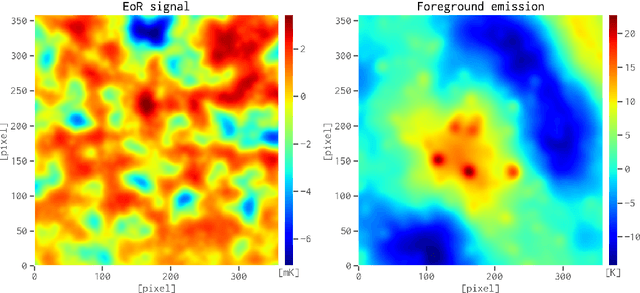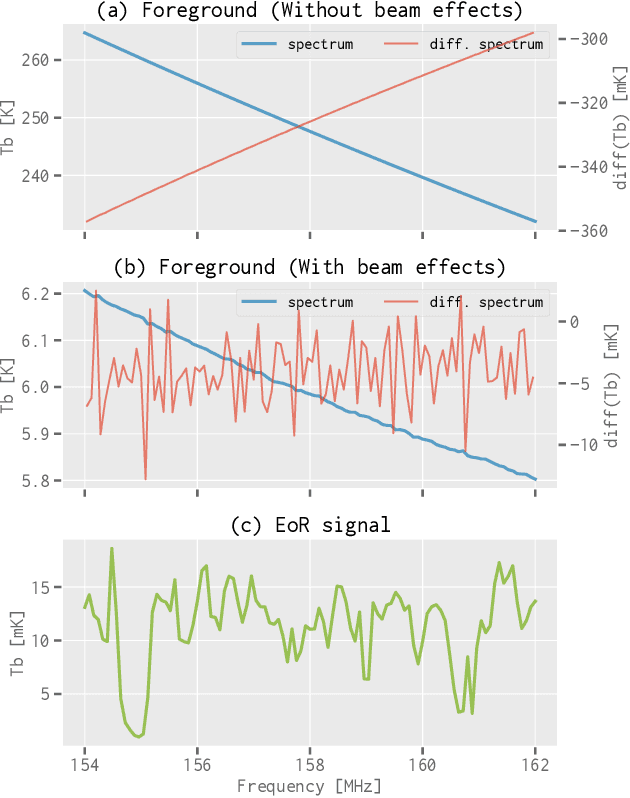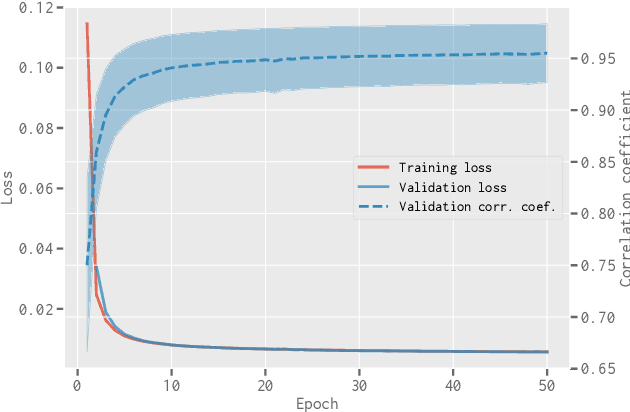Zhixian Ma
Separating the EoR Signal with a Convolutional Denoising Autoencoder: A Deep-learning-based Method
Mar 14, 2019



Abstract:When applying the foreground removal methods to uncover the faint cosmological signal from the epoch of reionization (EoR), the foreground spectra are assumed to be smooth. However, this assumption can be seriously violated in practice since the unresolved or mis-subtracted foreground sources, which are further complicated by the frequency-dependent beam effects of interferometers, will generate significant fluctuations along the frequency dimension. To address this issue, we propose a novel deep-learning-based method that uses a 9-layer convolutional denoising autoencoder (CDAE) to separate the EoR signal. After being trained on the SKA images simulated with realistic beam effects, the CDAE achieves excellent performance as the mean correlation coefficient ($\bar{\rho}$) between the reconstructed and input EoR signals reaches $0.929 \pm 0.045$. In comparison, the two representative traditional methods, namely the polynomial fitting method and the continuous wavelet transform method, both have difficulties in modelling and removing the foreground emission complicated with the beam effects, yielding only $\bar{\rho}_{\text{poly}} = 0.296 \pm 0.121$ and $\bar{\rho}_{\text{cwt}} = 0.198 \pm 0.160$, respectively. We conclude that, by hierarchically learning sophisticated features through multiple convolutional layers, the CDAE is a powerful tool that can be used to overcome the complicated beam effects and accurately separate the EoR signal. Our results also exhibit the great potential of deep-learning-based methods in future EoR experiments.
* 10 pages, 9 figures; minor text updates to match the MNRAS published version
Radio Galaxy Morphology Generation Using DNN Autoencoder and Gaussian Mixture Models
Jun 01, 2018



Abstract:The morphology of a radio galaxy is highly affected by its central active galactic nuclei (AGN), which is studied to reveal the evolution of the super massive black hole (SMBH). In this work, we propose a morphology generation framework for two typical radio galaxies namely Fanaroff-Riley type-I (FRI) and type-II (FRII) with deep neural network based autoencoder (DNNAE) and Gaussian mixture models (GMMs). The encoder and decoder subnets in the DNNAE are symmetric aside a fully-connected layer namely code layer hosting the extracted feature vectors. By randomly generating the feature vectors later with a three-component Gaussian Mixture models, new FRI or FRII radio galaxy morphologies are simulated. Experiments were demonstrated on real radio galaxy images, where we discussed the length of feature vectors, selection of lost functions, and made comparisons on batch normalization and dropout techniques for training the network. The results suggest a high efficiency and performance of our morphology generation framework. Code is available at: https://github.com/myinxd/dnnae-gmm.
X-ray Astronomical Point Sources Recognition Using Granular Binary-tree SVM
Mar 07, 2017



Abstract:The study on point sources in astronomical images is of special importance, since most energetic celestial objects in the Universe exhibit a point-like appearance. An approach to recognize the point sources (PS) in the X-ray astronomical images using our newly designed granular binary-tree support vector machine (GBT-SVM) classifier is proposed. First, all potential point sources are located by peak detection on the image. The image and spectral features of these potential point sources are then extracted. Finally, a classifier to recognize the true point sources is build through the extracted features. Experiments and applications of our approach on real X-ray astronomical images are demonstrated. comparisons between our approach and other SVM-based classifiers are also carried out by evaluating the precision and recall rates, which prove that our approach is better and achieves a higher accuracy of around 89%.
 Add to Chrome
Add to Chrome Add to Firefox
Add to Firefox Add to Edge
Add to Edge